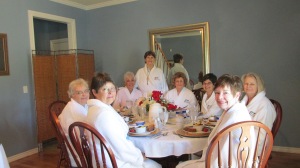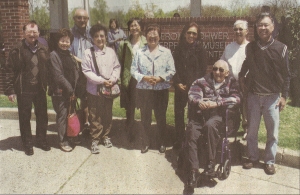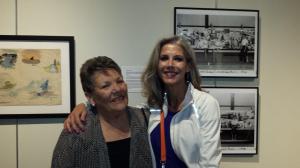“The Red Kimono tells it all—the bitterness and pain as well as the joy, pride and patriotism of a people too resilient to be beaten by racism.”
—Sandra Dallas, New York Times bestselling author of
Tallgrass and True Sisters
In my previous post titled “Updates: Japanese-American Relocation Camp Museum; Camp Nine; Relocation, Arkansas” I examined these three subjects a year after I had written about them in posts on my blog.
Since that time there has been one correction. There have now been visitors to the museum from forty-five states and more than one hundred cities in Arkansas.
(To read the original posts from a year ago, click on the following titles: “Opening of WWII Japanese American Internment Camps Museum” (March 20, 2013) and “Camp Nine: A Book Review with Quotes about the Arkansas Delta” (April 18, 2013.)
Now in this follow-up post I present an update of The Red Kimono, by Jan Morrill, the other book about the relocation camp at Rohwer, near my hometown of McGehee, Arkansas, which I reviewed a year ago. (To read that review titled “The Red Kimono: A Book Review about WWII Japanese Relocation Camps” (May 9, 2013), click on the title.)
In order to write this update I requested that Jan send me information and photos about her and her book since that post a year ago. (To learn more about Jan and her writings, visit her Web site at: http://www.janmorrill.com/.)

Jam Morrill holding a copy of The Red Kimono (to magnify, click on the photo taken from Jan’s Web site)
Following is part of what Jan wrote to me in response to my request for an update:
1) In August, The Red Kimono was selected as an Editor’s Choice by the Historical Novel Society. [A review of the book can be found at]
http://historicalnovelsociety.org/reviews/the-red-kimono/
2) In May, The Red Kimono was selected as the Best Published Book by the Oklahoma Writers Federation.
3) I recently published a book of haiku titled, Life: Haiku by Haiku. Many of the haiku from The Red Kimono appear in the book, and were read by Susan Gallion [curator of the WWII Japanese-American Museum in McGehee, Arkansas, see the previous post] at the anniversary celebration of the museum.
4) In August, I will be speaking to the Japan America Society of Chicago.
5) I am currently working on the sequel to The Red Kimono.
I am sure that all who are interested in the relocation camps, especially the two near McGehee, would like to congratulate Jan on her writing awards and will look forward to the sequel to The Red Kimono. I will keep readers updated on this subject in this blog.
Meanwhile, to view a brief video interview with Charlotte Schexnayder, the former editor of the McGehee Times, on her experience with the camp at Rohwer, click here.
The Clique Meeting in Tulsa
“The Old South will never die, not as long as there are darling debutantes, doting docents, indomitable dowagers, and other groups of proud Southern women like the Junior League, the Ya Ya Sisterhood, the Sweet Potato Queens, the Steel Magnolias—and the Maggie [McGehee] Clique!”
–Quote by Jimmy Peacock in letter
to Charles Allbright, the Arkansas Traveler columnist,
dated June 10, 2002
As indicated by the self-quote above, my next update is about the Maggie Clique, a group of “girls” from the McGehee, Arkansas, high school class of 1960 who have met together annually since 1991, which must be some kind of record.
This particular update marks an addition to a blog post I published on June 8, 2011, almost three years ago, titled “My Annual Tributes to the Clique.” (To read those annual poetic tributes accompanied by photos of the Clique over the years and of the greeting cards I sent to them with each tribute, click on the title of the post.)
This year the Clique met in Tulsa on May 1-4 with a special luncheon to which I was invited to attend at Miss Scarlett’s Tea Room in the historic Southern-style residence called the Burnett Mansion in Sapulpa where we live. The Clique had met the two previous years on the beach in Florida. Mari missed those two meetings because of my failing health; she would not leave me alone while she was gone that far away for a whole week. So the Clique graciously voted to meet this year closer to our residence.

The historic Southern-style Burnett Mansion, home of the fashionable Miss Scarlett’s Tea Room, in Sapulpa, Oklahoma, where the Clique held its formal luncheon on Friday, May 2 (to magnify, click on the photo)
Here is my tribute and thank-you to them accompanied by a bouquet of red and white spring flowers and a greeting card with this poem inside which I composed:
The Maggie Clique came to Tulsa . . .
. . . for the sake of my dear wife,
to try to save her husband’s life.
I wish that they would never [de]part,
‘cause they take with them my grateful heart!
Blessed art y’all among women!

The Clique on the side steps of the Burnett Mansion at their formal luncheon on Friday, May 2, 2014 (Mari is the blonde on the left in the first row) (to magnify, click on the photo)
Since I have known these “girls” most of their lives and dated and/or double-dated several of them, as an “honorary member of the Clique” (a title conferred on me in 2000 with the gift of a tee-shirt with that inscription on it), I felt I could take the liberty of sharing with them in my card a bit of “chick reunion” humor from an older Southern Gentleman and Scholar:
“The Ladies’ Meeting at the Ocean Springs Café”

The Clique in their white bathrobes at breakfast in their bed and breakfast inn in Tulsa during their May 1-4 meeting (to magnify, click on the photo)
Here is a story about a group of Southern ladies who met together like the Maggie Clique, except that they met every ten years.
When they were forty years old, someone said, “Where shall we go to eat?” One of them said, “Oh, let’s go to the Ocean Springs Café, because the waiters there are all young, handsome, flirty, and wear tight uniforms.”
When they were fifty years old, someone said, “Where shall we go to eat?” One of them said, “Oh, let’s go to the Ocean Springs Café, because the food there is delicious, and it is all low-fat and low-cholesterol!”
When they were sixty years old, someone said, “Where shall we go to eat?” One of them said, “Oh, let’s go to the Ocean Springs Café, because the restrooms there are so clean and so big and well-equipped that you never have to stand in line!”
When they were seventy years old, someone said, “Where shall we go to eat?” One of them said, “Oh, let’s go to the Ocean Springs Café, because it is handicap accessible with wheelchair ramps and everything!”
When they were eighty years old, someone said, “Where shall we go to eat?” One of them said, “Oh, let’s go to the Ocean Springs Café, because . . . we’ve never been there!”
—Jimmy Peacock, quoting Dr. Paul Talmadge
his former dean in Anderson, South Carolina
My High School Senior Trip and Graduation
“When the ivy walls
Are far behind,
No matter where our paths may wind,
We’ll remember always
Graduation day.
We’ll remember always
Graduation day.”
—“Graduation Day”
(To hear this song being sung by the Four Freshmen,
click on the title above.
To view the full lyrics to the song, click here.)
In a post titled “Moments to Remember/Selma Methodist Church Update” published on May 23, 2012, I quoted some of the lyrics of another graduation day song titled “Moments to Remember.” That song happened to be our McGehee High School Class of 1956 graduating class song.

McGehee, Arkansas, High School Class of 1956; I am the fourth student from the left in the second row from the back (to magnify, click on the photo)
To read this post about our senior class trip to Petit Jean State Park, click on the title above.
However, although the post was published on May 23, 2012, the actual graduation ceremony took place on May 14, 1956—fifty-eight years ago!
In either case, regardless of the precise day, it is another one of the precious “Month of May Updates” in this nostalgic blog post in an effort to assure that “we’ll remember always: Graduation Day.”
In the next post I will provide a follow-up and progress report on the other subject on this post, the Selma Methodist Church and a few more month of May updates.














